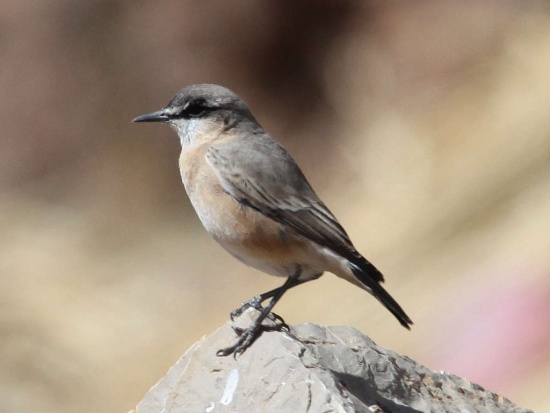Alternative name: Botta's Wheatear
- Oenanthe bottae
Identification
15–16 cm (6-6¼ in)
- Greyish-brown forecrown
- Brownish-grey mantle and back
- White supercilium
- Dark eye mask
- Pale orangey-buff breast and flanks
- Whitish underparts
- White rump
Sexes similar
Juvenile: paler with buff spots on upperparts, dark scaly feathers on underparts
Distribution
Arabian Peninsula, highlands between Mecca to Yemen.
Taxonomy
This species was formerly joined with Rusty-breasted Wheatear under the name of Red-breasted Wheatear.
Subspecies
This is a monotypic species[1].
Habitat
Sparsely vegetated hillsides and cultivated terraces mostly around 2300–3000 m.
Behaviour
They often bob their tails.
Diet
Their main diet consists of insects and their larvae. Little other detail is known.
Breeding
There is not a lot known. They place their nests in field walls, banks, under boulders or rodent burrows. They appear to breed throughout the year.
References
- Clements, J. F., T. S. Schulenberg, M. J. Iliff, T. A. Fredericks, J. A. Gerbracht, D. Lepage, S. M. Billerman, B. L. Sullivan, and C. L. Wood. 2022. The eBird/Clements checklist of Birds of the World: v2022. Downloaded from https://www.birds.cornell.edu/clementschecklist/download/
- Gill, F, D Donsker, and P Rasmussen (Eds). 2023. IOC World Bird List (v 13.2). Doi 10.14344/IOC.ML.13.2. http://www.worldbirdnames.org/
- Avibase
- Collar, N., J. del Hoyo, G. M. Kirwan, and D. A. Christie (2020). Red-breasted Wheatear (Oenanthe bottae), version 1.0. In Birds of the World (S. M. Billerman, B. K. Keeney, P. G. Rodewald, and T. S. Schulenberg, Editors). Cornell Lab of Ornithology, Ithaca, NY, USA. https://doi.org/10.2173/bow.rebwhe1.01
Recommended Citation
- BirdForum Opus contributors. (2025) Buff-breasted Wheatear. In: BirdForum, the forum for wild birds and birding. Retrieved 13 May 2025 from https://www.birdforum.net/opus/Buff-breasted_Wheatear
External Links
GSearch checked for 2020 platform.1




